Journal Article Critique: International Business Review Article
VerifiedAdded on 2020/04/21
|10
|2533
|481
Journal and Reflective Writing
AI Summary
This journal article critique analyzes the article "Why does MNE performance vary across countries? An inquiry into the competitive value of MNE assets" published in the International Business Review. The critique summarizes the article's purpose, which is to investigate how the performance of Mul...
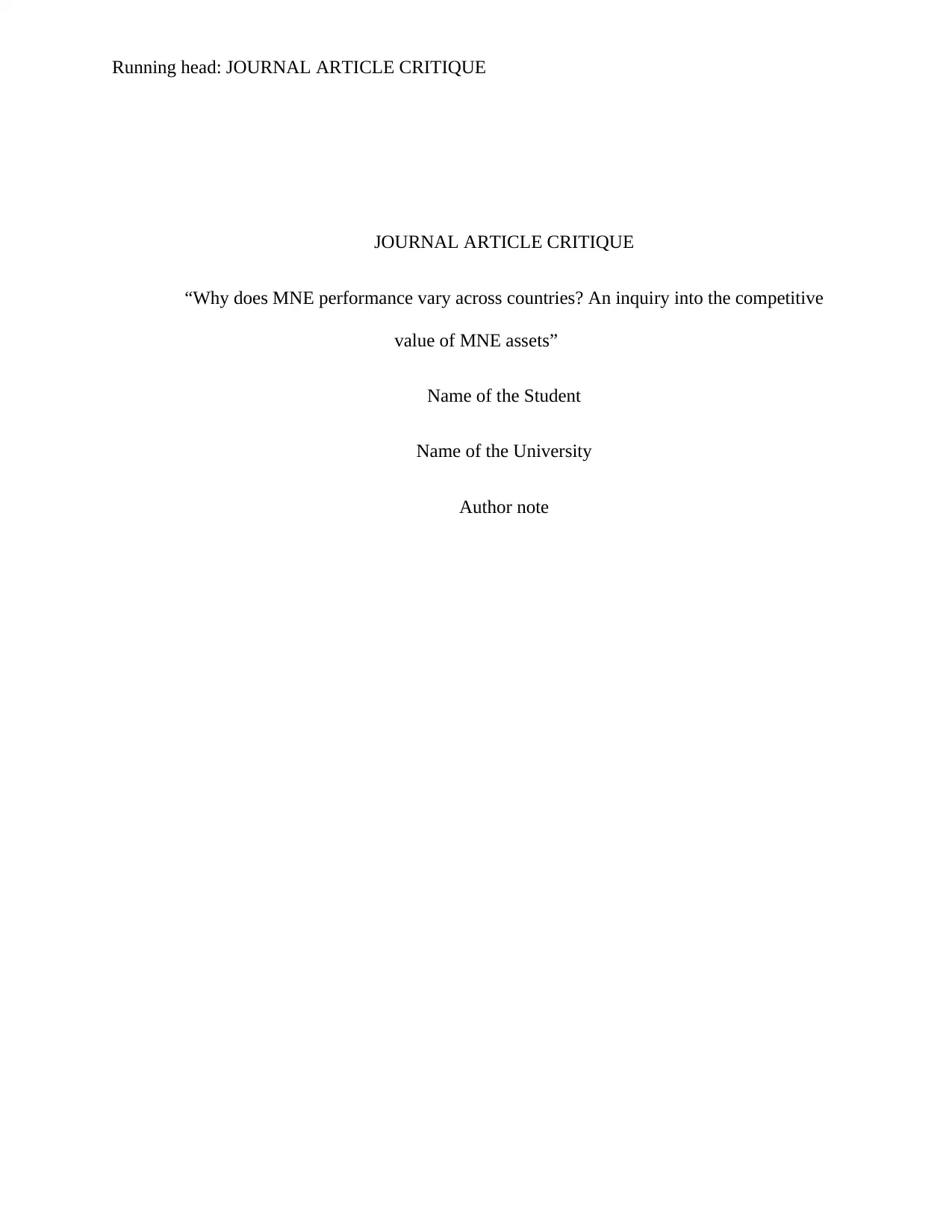
Running head: JOURNAL ARTICLE CRITIQUE
JOURNAL ARTICLE CRITIQUE
“Why does MNE performance vary across countries? An inquiry into the competitive
value of MNE assets”
Name of the Student
Name of the University
Author note
JOURNAL ARTICLE CRITIQUE
“Why does MNE performance vary across countries? An inquiry into the competitive
value of MNE assets”
Name of the Student
Name of the University
Author note
Secure Best Marks with AI Grader
Need help grading? Try our AI Grader for instant feedback on your assignments.
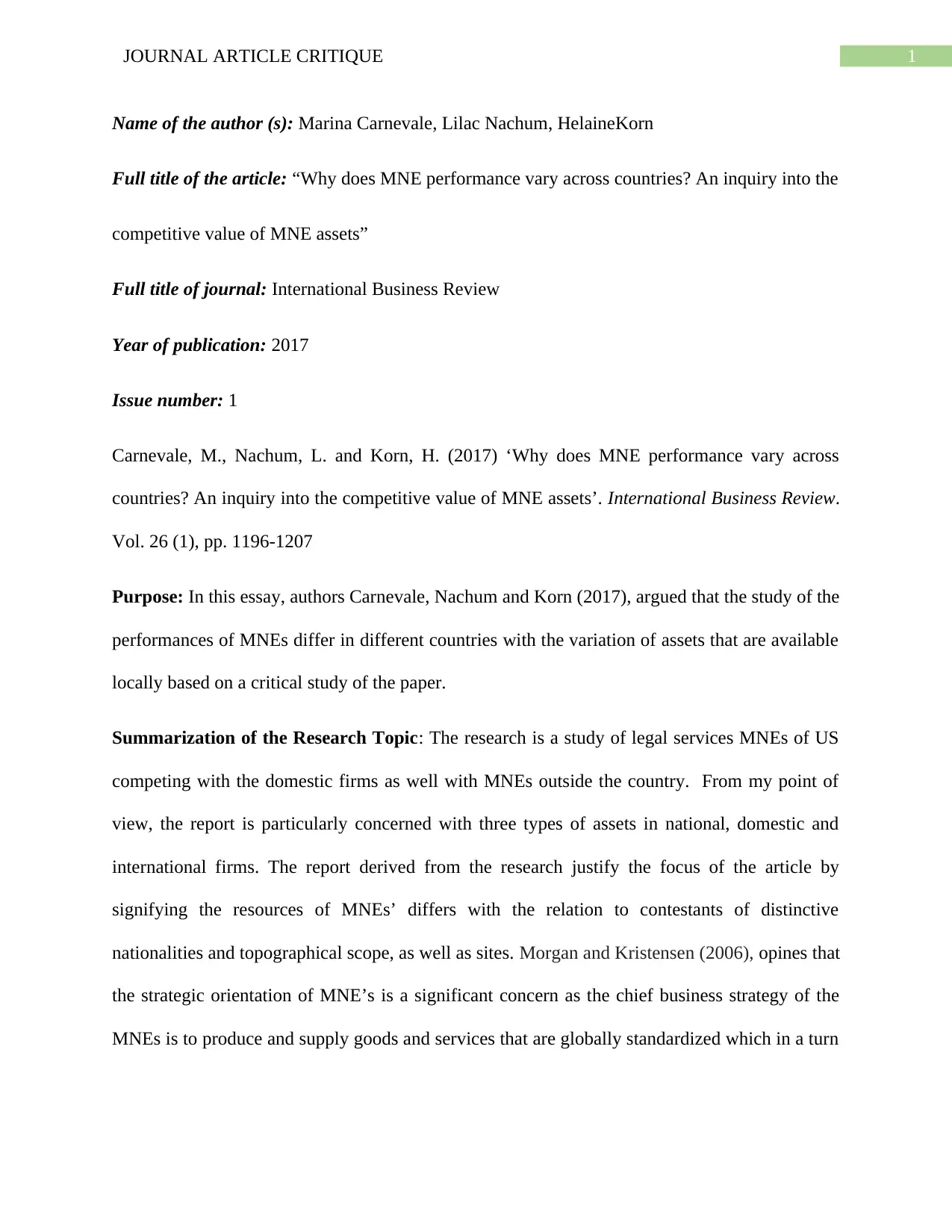
1JOURNAL ARTICLE CRITIQUE
Name of the author (s): Marina Carnevale, Lilac Nachum, HelaineKorn
Full title of the article: “Why does MNE performance vary across countries? An inquiry into the
competitive value of MNE assets”
Full title of journal: International Business Review
Year of publication: 2017
Issue number: 1
Carnevale, M., Nachum, L. and Korn, H. (2017) ‘Why does MNE performance vary across
countries? An inquiry into the competitive value of MNE assets’. International Business Review.
Vol. 26 (1), pp. 1196-1207
Purpose: In this essay, authors Carnevale, Nachum and Korn (2017), argued that the study of the
performances of MNEs differ in different countries with the variation of assets that are available
locally based on a critical study of the paper.
Summarization of the Research Topic: The research is a study of legal services MNEs of US
competing with the domestic firms as well with MNEs outside the country. From my point of
view, the report is particularly concerned with three types of assets in national, domestic and
international firms. The report derived from the research justify the focus of the article by
signifying the resources of MNEs’ differs with the relation to contestants of distinctive
nationalities and topographical scope, as well as sites. Morgan and Kristensen (2006), opines that
the strategic orientation of MNE’s is a significant concern as the chief business strategy of the
MNEs is to produce and supply goods and services that are globally standardized which in a turn
Name of the author (s): Marina Carnevale, Lilac Nachum, HelaineKorn
Full title of the article: “Why does MNE performance vary across countries? An inquiry into the
competitive value of MNE assets”
Full title of journal: International Business Review
Year of publication: 2017
Issue number: 1
Carnevale, M., Nachum, L. and Korn, H. (2017) ‘Why does MNE performance vary across
countries? An inquiry into the competitive value of MNE assets’. International Business Review.
Vol. 26 (1), pp. 1196-1207
Purpose: In this essay, authors Carnevale, Nachum and Korn (2017), argued that the study of the
performances of MNEs differ in different countries with the variation of assets that are available
locally based on a critical study of the paper.
Summarization of the Research Topic: The research is a study of legal services MNEs of US
competing with the domestic firms as well with MNEs outside the country. From my point of
view, the report is particularly concerned with three types of assets in national, domestic and
international firms. The report derived from the research justify the focus of the article by
signifying the resources of MNEs’ differs with the relation to contestants of distinctive
nationalities and topographical scope, as well as sites. Morgan and Kristensen (2006), opines that
the strategic orientation of MNE’s is a significant concern as the chief business strategy of the
MNEs is to produce and supply goods and services that are globally standardized which in a turn
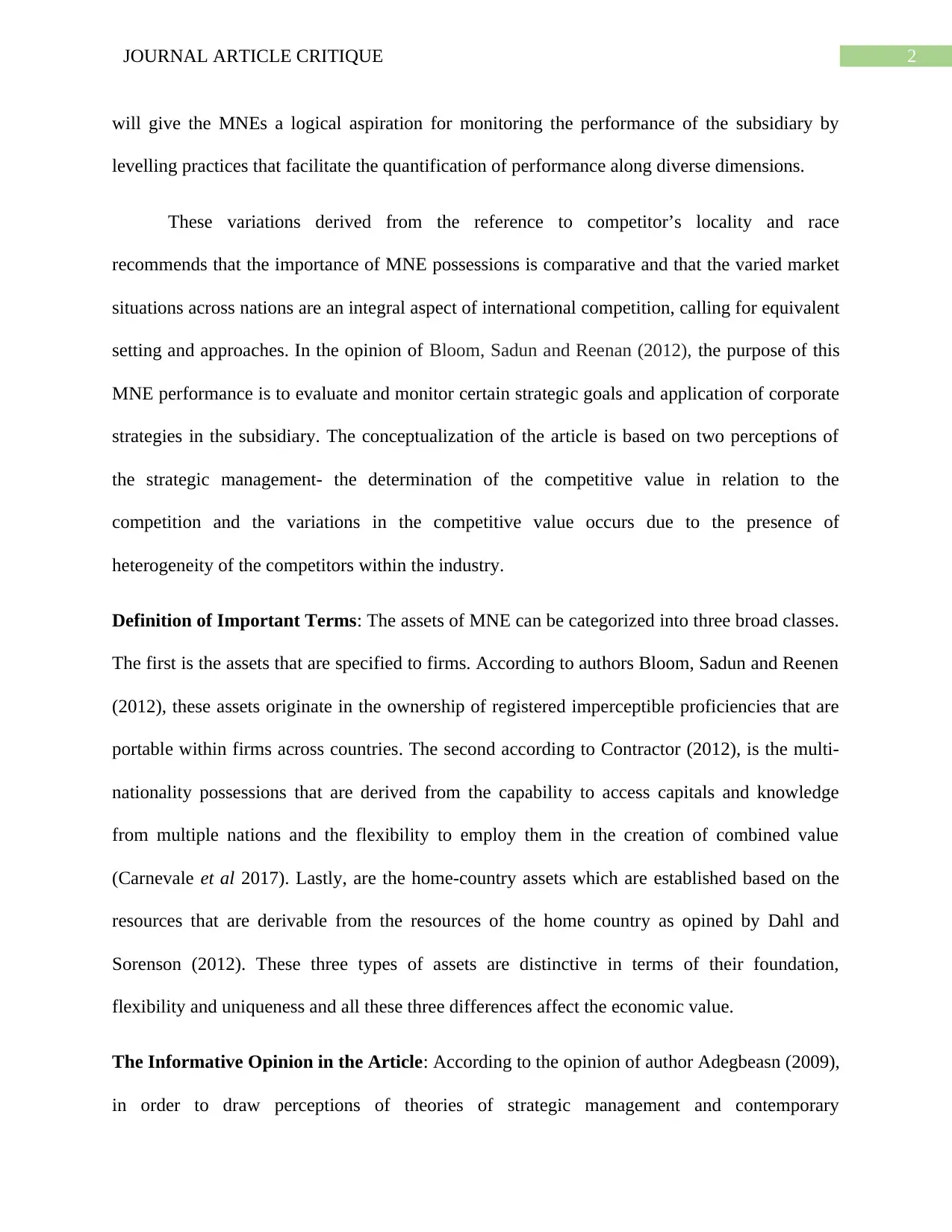
2JOURNAL ARTICLE CRITIQUE
will give the MNEs a logical aspiration for monitoring the performance of the subsidiary by
levelling practices that facilitate the quantification of performance along diverse dimensions.
These variations derived from the reference to competitor’s locality and race
recommends that the importance of MNE possessions is comparative and that the varied market
situations across nations are an integral aspect of international competition, calling for equivalent
setting and approaches. In the opinion of Bloom, Sadun and Reenan (2012), the purpose of this
MNE performance is to evaluate and monitor certain strategic goals and application of corporate
strategies in the subsidiary. The conceptualization of the article is based on two perceptions of
the strategic management- the determination of the competitive value in relation to the
competition and the variations in the competitive value occurs due to the presence of
heterogeneity of the competitors within the industry.
Definition of Important Terms: The assets of MNE can be categorized into three broad classes.
The first is the assets that are specified to firms. According to authors Bloom, Sadun and Reenen
(2012), these assets originate in the ownership of registered imperceptible proficiencies that are
portable within firms across countries. The second according to Contractor (2012), is the multi-
nationality possessions that are derived from the capability to access capitals and knowledge
from multiple nations and the flexibility to employ them in the creation of combined value
(Carnevale et al 2017). Lastly, are the home-country assets which are established based on the
resources that are derivable from the resources of the home country as opined by Dahl and
Sorenson (2012). These three types of assets are distinctive in terms of their foundation,
flexibility and uniqueness and all these three differences affect the economic value.
The Informative Opinion in the Article: According to the opinion of author Adegbeasn (2009),
in order to draw perceptions of theories of strategic management and contemporary
will give the MNEs a logical aspiration for monitoring the performance of the subsidiary by
levelling practices that facilitate the quantification of performance along diverse dimensions.
These variations derived from the reference to competitor’s locality and race
recommends that the importance of MNE possessions is comparative and that the varied market
situations across nations are an integral aspect of international competition, calling for equivalent
setting and approaches. In the opinion of Bloom, Sadun and Reenan (2012), the purpose of this
MNE performance is to evaluate and monitor certain strategic goals and application of corporate
strategies in the subsidiary. The conceptualization of the article is based on two perceptions of
the strategic management- the determination of the competitive value in relation to the
competition and the variations in the competitive value occurs due to the presence of
heterogeneity of the competitors within the industry.
Definition of Important Terms: The assets of MNE can be categorized into three broad classes.
The first is the assets that are specified to firms. According to authors Bloom, Sadun and Reenen
(2012), these assets originate in the ownership of registered imperceptible proficiencies that are
portable within firms across countries. The second according to Contractor (2012), is the multi-
nationality possessions that are derived from the capability to access capitals and knowledge
from multiple nations and the flexibility to employ them in the creation of combined value
(Carnevale et al 2017). Lastly, are the home-country assets which are established based on the
resources that are derivable from the resources of the home country as opined by Dahl and
Sorenson (2012). These three types of assets are distinctive in terms of their foundation,
flexibility and uniqueness and all these three differences affect the economic value.
The Informative Opinion in the Article: According to the opinion of author Adegbeasn (2009),
in order to draw perceptions of theories of strategic management and contemporary
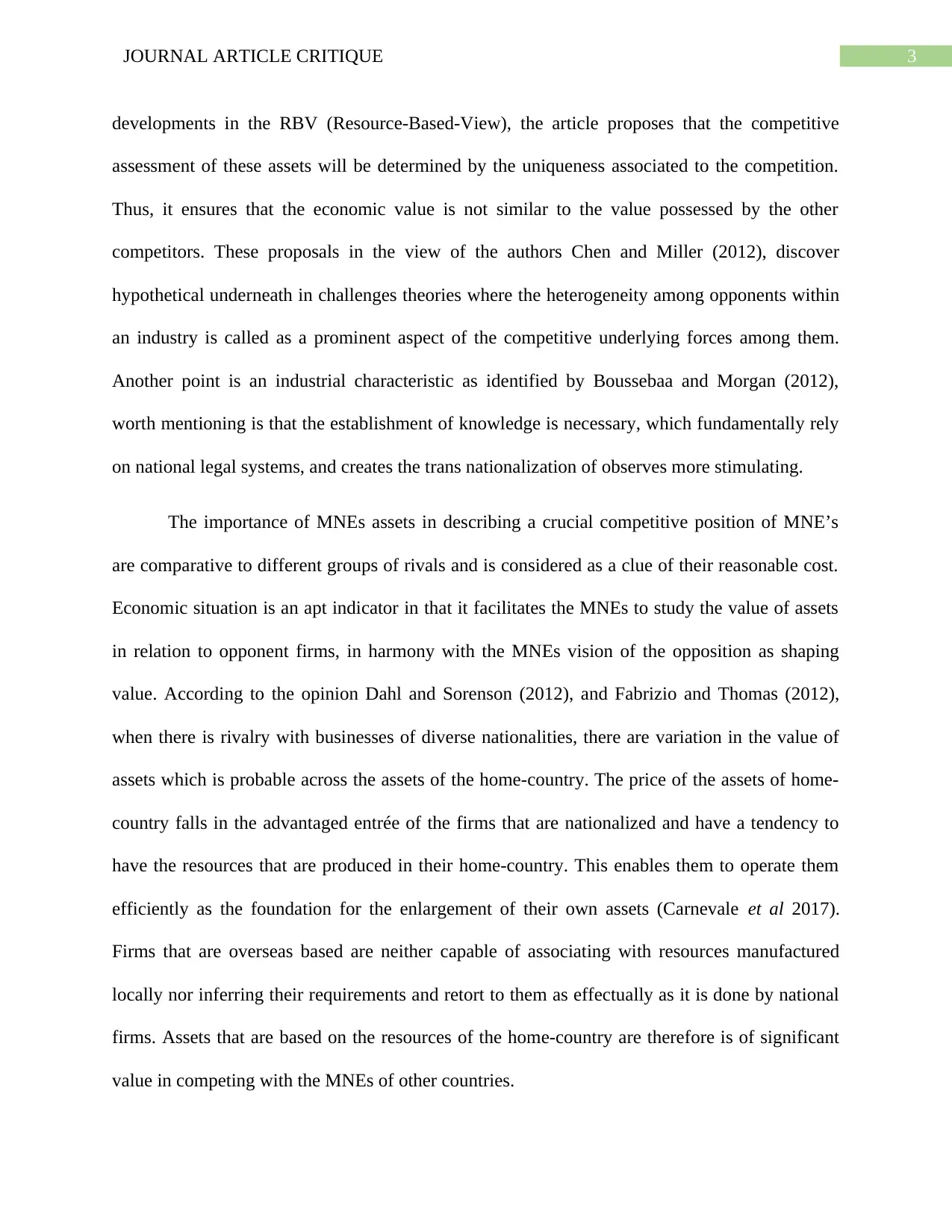
3JOURNAL ARTICLE CRITIQUE
developments in the RBV (Resource-Based-View), the article proposes that the competitive
assessment of these assets will be determined by the uniqueness associated to the competition.
Thus, it ensures that the economic value is not similar to the value possessed by the other
competitors. These proposals in the view of the authors Chen and Miller (2012), discover
hypothetical underneath in challenges theories where the heterogeneity among opponents within
an industry is called as a prominent aspect of the competitive underlying forces among them.
Another point is an industrial characteristic as identified by Boussebaa and Morgan (2012),
worth mentioning is that the establishment of knowledge is necessary, which fundamentally rely
on national legal systems, and creates the trans nationalization of observes more stimulating.
The importance of MNEs assets in describing a crucial competitive position of MNE’s
are comparative to different groups of rivals and is considered as a clue of their reasonable cost.
Economic situation is an apt indicator in that it facilitates the MNEs to study the value of assets
in relation to opponent firms, in harmony with the MNEs vision of the opposition as shaping
value. According to the opinion Dahl and Sorenson (2012), and Fabrizio and Thomas (2012),
when there is rivalry with businesses of diverse nationalities, there are variation in the value of
assets which is probable across the assets of the home-country. The price of the assets of home-
country falls in the advantaged entrée of the firms that are nationalized and have a tendency to
have the resources that are produced in their home-country. This enables them to operate them
efficiently as the foundation for the enlargement of their own assets (Carnevale et al 2017).
Firms that are overseas based are neither capable of associating with resources manufactured
locally nor inferring their requirements and retort to them as effectually as it is done by national
firms. Assets that are based on the resources of the home-country are therefore is of significant
value in competing with the MNEs of other countries.
developments in the RBV (Resource-Based-View), the article proposes that the competitive
assessment of these assets will be determined by the uniqueness associated to the competition.
Thus, it ensures that the economic value is not similar to the value possessed by the other
competitors. These proposals in the view of the authors Chen and Miller (2012), discover
hypothetical underneath in challenges theories where the heterogeneity among opponents within
an industry is called as a prominent aspect of the competitive underlying forces among them.
Another point is an industrial characteristic as identified by Boussebaa and Morgan (2012),
worth mentioning is that the establishment of knowledge is necessary, which fundamentally rely
on national legal systems, and creates the trans nationalization of observes more stimulating.
The importance of MNEs assets in describing a crucial competitive position of MNE’s
are comparative to different groups of rivals and is considered as a clue of their reasonable cost.
Economic situation is an apt indicator in that it facilitates the MNEs to study the value of assets
in relation to opponent firms, in harmony with the MNEs vision of the opposition as shaping
value. According to the opinion Dahl and Sorenson (2012), and Fabrizio and Thomas (2012),
when there is rivalry with businesses of diverse nationalities, there are variation in the value of
assets which is probable across the assets of the home-country. The price of the assets of home-
country falls in the advantaged entrée of the firms that are nationalized and have a tendency to
have the resources that are produced in their home-country. This enables them to operate them
efficiently as the foundation for the enlargement of their own assets (Carnevale et al 2017).
Firms that are overseas based are neither capable of associating with resources manufactured
locally nor inferring their requirements and retort to them as effectually as it is done by national
firms. Assets that are based on the resources of the home-country are therefore is of significant
value in competing with the MNEs of other countries.
Secure Best Marks with AI Grader
Need help grading? Try our AI Grader for instant feedback on your assignments.
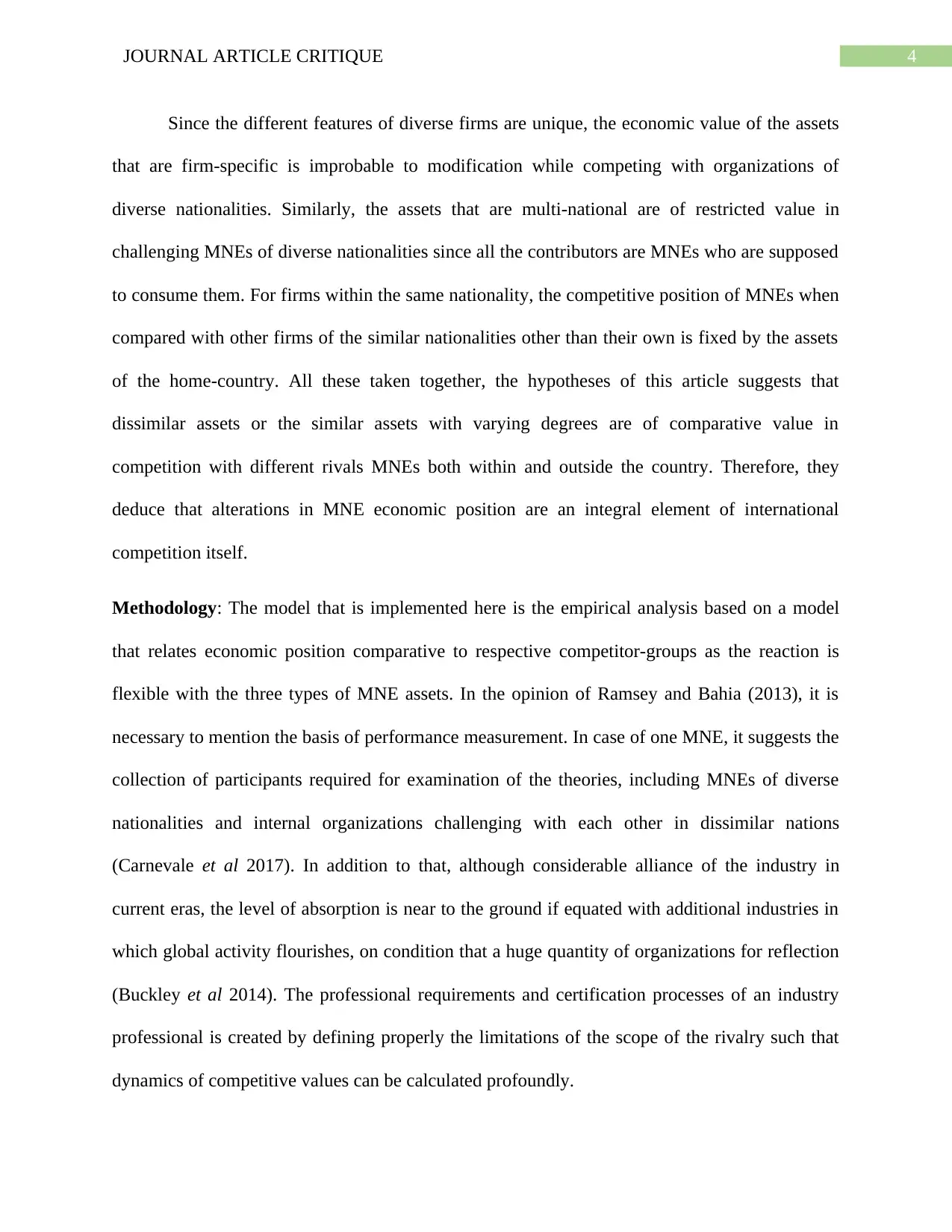
4JOURNAL ARTICLE CRITIQUE
Since the different features of diverse firms are unique, the economic value of the assets
that are firm-specific is improbable to modification while competing with organizations of
diverse nationalities. Similarly, the assets that are multi-national are of restricted value in
challenging MNEs of diverse nationalities since all the contributors are MNEs who are supposed
to consume them. For firms within the same nationality, the competitive position of MNEs when
compared with other firms of the similar nationalities other than their own is fixed by the assets
of the home-country. All these taken together, the hypotheses of this article suggests that
dissimilar assets or the similar assets with varying degrees are of comparative value in
competition with different rivals MNEs both within and outside the country. Therefore, they
deduce that alterations in MNE economic position are an integral element of international
competition itself.
Methodology: The model that is implemented here is the empirical analysis based on a model
that relates economic position comparative to respective competitor-groups as the reaction is
flexible with the three types of MNE assets. In the opinion of Ramsey and Bahia (2013), it is
necessary to mention the basis of performance measurement. In case of one MNE, it suggests the
collection of participants required for examination of the theories, including MNEs of diverse
nationalities and internal organizations challenging with each other in dissimilar nations
(Carnevale et al 2017). In addition to that, although considerable alliance of the industry in
current eras, the level of absorption is near to the ground if equated with additional industries in
which global activity flourishes, on condition that a huge quantity of organizations for reflection
(Buckley et al 2014). The professional requirements and certification processes of an industry
professional is created by defining properly the limitations of the scope of the rivalry such that
dynamics of competitive values can be calculated profoundly.
Since the different features of diverse firms are unique, the economic value of the assets
that are firm-specific is improbable to modification while competing with organizations of
diverse nationalities. Similarly, the assets that are multi-national are of restricted value in
challenging MNEs of diverse nationalities since all the contributors are MNEs who are supposed
to consume them. For firms within the same nationality, the competitive position of MNEs when
compared with other firms of the similar nationalities other than their own is fixed by the assets
of the home-country. All these taken together, the hypotheses of this article suggests that
dissimilar assets or the similar assets with varying degrees are of comparative value in
competition with different rivals MNEs both within and outside the country. Therefore, they
deduce that alterations in MNE economic position are an integral element of international
competition itself.
Methodology: The model that is implemented here is the empirical analysis based on a model
that relates economic position comparative to respective competitor-groups as the reaction is
flexible with the three types of MNE assets. In the opinion of Ramsey and Bahia (2013), it is
necessary to mention the basis of performance measurement. In case of one MNE, it suggests the
collection of participants required for examination of the theories, including MNEs of diverse
nationalities and internal organizations challenging with each other in dissimilar nations
(Carnevale et al 2017). In addition to that, although considerable alliance of the industry in
current eras, the level of absorption is near to the ground if equated with additional industries in
which global activity flourishes, on condition that a huge quantity of organizations for reflection
(Buckley et al 2014). The professional requirements and certification processes of an industry
professional is created by defining properly the limitations of the scope of the rivalry such that
dynamics of competitive values can be calculated profoundly.
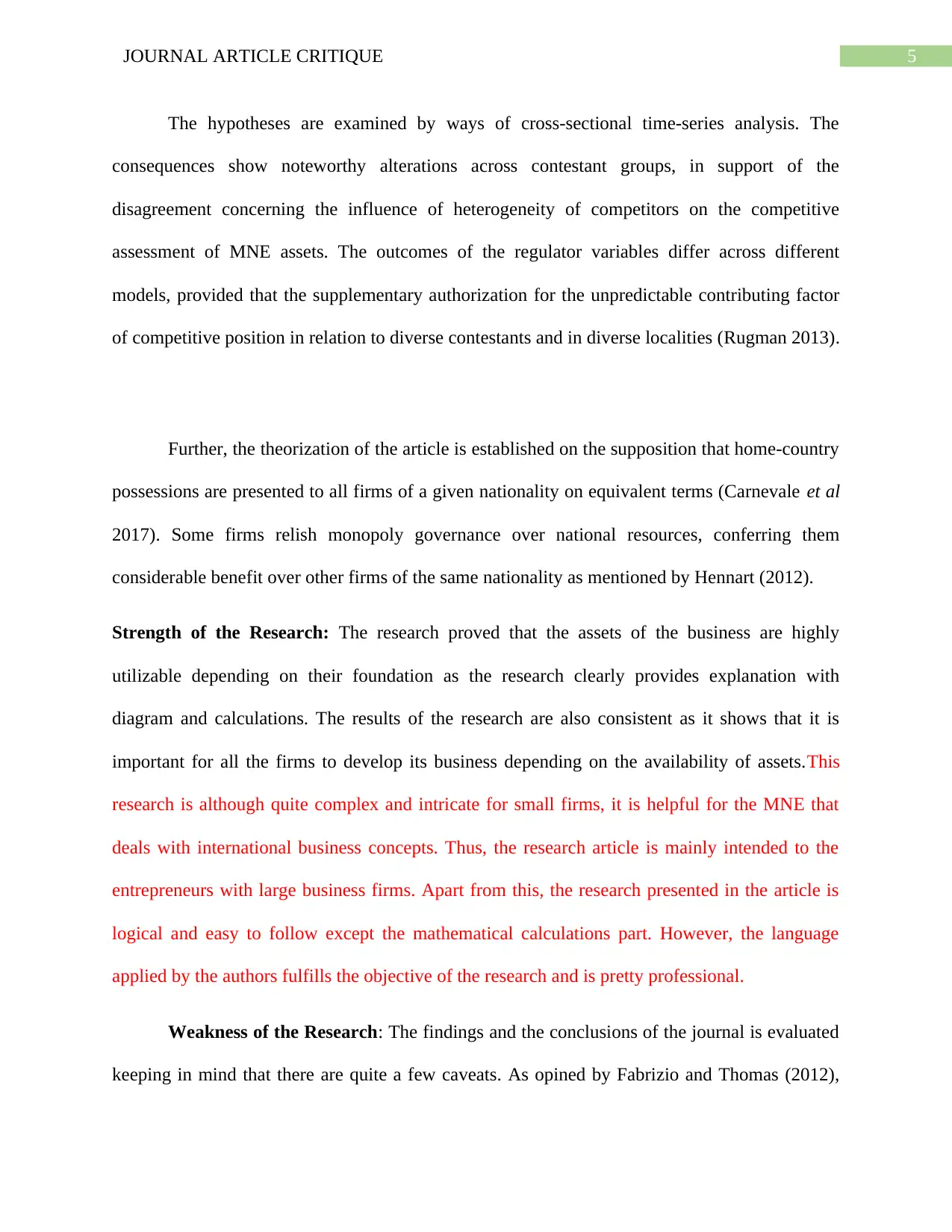
5JOURNAL ARTICLE CRITIQUE
The hypotheses are examined by ways of cross-sectional time-series analysis. The
consequences show noteworthy alterations across contestant groups, in support of the
disagreement concerning the influence of heterogeneity of competitors on the competitive
assessment of MNE assets. The outcomes of the regulator variables differ across different
models, provided that the supplementary authorization for the unpredictable contributing factor
of competitive position in relation to diverse contestants and in diverse localities (Rugman 2013).
Further, the theorization of the article is established on the supposition that home-country
possessions are presented to all firms of a given nationality on equivalent terms (Carnevale et al
2017). Some firms relish monopoly governance over national resources, conferring them
considerable benefit over other firms of the same nationality as mentioned by Hennart (2012).
Strength of the Research: The research proved that the assets of the business are highly
utilizable depending on their foundation as the research clearly provides explanation with
diagram and calculations. The results of the research are also consistent as it shows that it is
important for all the firms to develop its business depending on the availability of assets.This
research is although quite complex and intricate for small firms, it is helpful for the MNE that
deals with international business concepts. Thus, the research article is mainly intended to the
entrepreneurs with large business firms. Apart from this, the research presented in the article is
logical and easy to follow except the mathematical calculations part. However, the language
applied by the authors fulfills the objective of the research and is pretty professional.
Weakness of the Research: The findings and the conclusions of the journal is evaluated
keeping in mind that there are quite a few caveats. As opined by Fabrizio and Thomas (2012),
The hypotheses are examined by ways of cross-sectional time-series analysis. The
consequences show noteworthy alterations across contestant groups, in support of the
disagreement concerning the influence of heterogeneity of competitors on the competitive
assessment of MNE assets. The outcomes of the regulator variables differ across different
models, provided that the supplementary authorization for the unpredictable contributing factor
of competitive position in relation to diverse contestants and in diverse localities (Rugman 2013).
Further, the theorization of the article is established on the supposition that home-country
possessions are presented to all firms of a given nationality on equivalent terms (Carnevale et al
2017). Some firms relish monopoly governance over national resources, conferring them
considerable benefit over other firms of the same nationality as mentioned by Hennart (2012).
Strength of the Research: The research proved that the assets of the business are highly
utilizable depending on their foundation as the research clearly provides explanation with
diagram and calculations. The results of the research are also consistent as it shows that it is
important for all the firms to develop its business depending on the availability of assets.This
research is although quite complex and intricate for small firms, it is helpful for the MNE that
deals with international business concepts. Thus, the research article is mainly intended to the
entrepreneurs with large business firms. Apart from this, the research presented in the article is
logical and easy to follow except the mathematical calculations part. However, the language
applied by the authors fulfills the objective of the research and is pretty professional.
Weakness of the Research: The findings and the conclusions of the journal is evaluated
keeping in mind that there are quite a few caveats. As opined by Fabrizio and Thomas (2012),
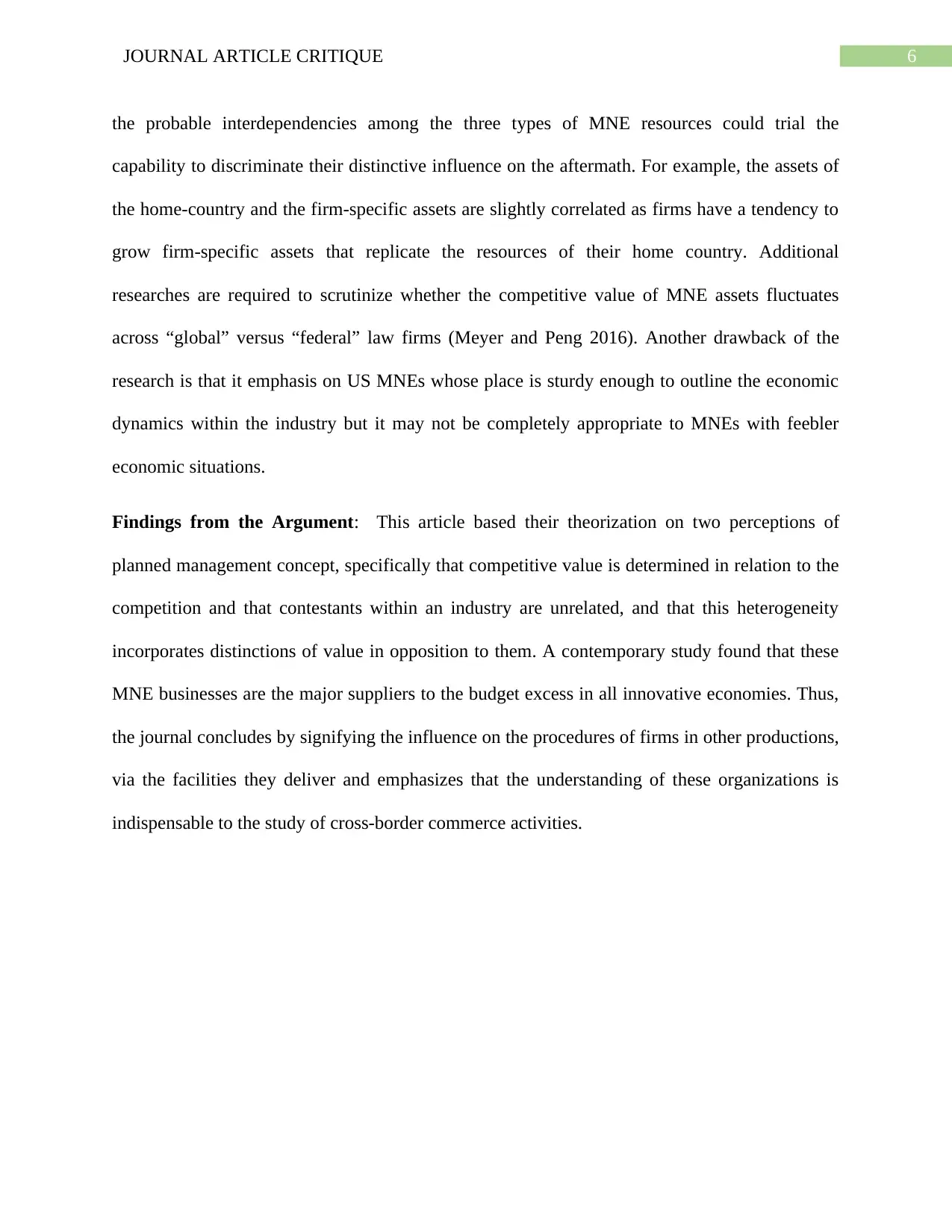
6JOURNAL ARTICLE CRITIQUE
the probable interdependencies among the three types of MNE resources could trial the
capability to discriminate their distinctive influence on the aftermath. For example, the assets of
the home-country and the firm-specific assets are slightly correlated as firms have a tendency to
grow firm-specific assets that replicate the resources of their home country. Additional
researches are required to scrutinize whether the competitive value of MNE assets fluctuates
across “global” versus “federal” law firms (Meyer and Peng 2016). Another drawback of the
research is that it emphasis on US MNEs whose place is sturdy enough to outline the economic
dynamics within the industry but it may not be completely appropriate to MNEs with feebler
economic situations.
Findings from the Argument: This article based their theorization on two perceptions of
planned management concept, specifically that competitive value is determined in relation to the
competition and that contestants within an industry are unrelated, and that this heterogeneity
incorporates distinctions of value in opposition to them. A contemporary study found that these
MNE businesses are the major suppliers to the budget excess in all innovative economies. Thus,
the journal concludes by signifying the influence on the procedures of firms in other productions,
via the facilities they deliver and emphasizes that the understanding of these organizations is
indispensable to the study of cross-border commerce activities.
the probable interdependencies among the three types of MNE resources could trial the
capability to discriminate their distinctive influence on the aftermath. For example, the assets of
the home-country and the firm-specific assets are slightly correlated as firms have a tendency to
grow firm-specific assets that replicate the resources of their home country. Additional
researches are required to scrutinize whether the competitive value of MNE assets fluctuates
across “global” versus “federal” law firms (Meyer and Peng 2016). Another drawback of the
research is that it emphasis on US MNEs whose place is sturdy enough to outline the economic
dynamics within the industry but it may not be completely appropriate to MNEs with feebler
economic situations.
Findings from the Argument: This article based their theorization on two perceptions of
planned management concept, specifically that competitive value is determined in relation to the
competition and that contestants within an industry are unrelated, and that this heterogeneity
incorporates distinctions of value in opposition to them. A contemporary study found that these
MNE businesses are the major suppliers to the budget excess in all innovative economies. Thus,
the journal concludes by signifying the influence on the procedures of firms in other productions,
via the facilities they deliver and emphasizes that the understanding of these organizations is
indispensable to the study of cross-border commerce activities.
Paraphrase This Document
Need a fresh take? Get an instant paraphrase of this document with our AI Paraphraser
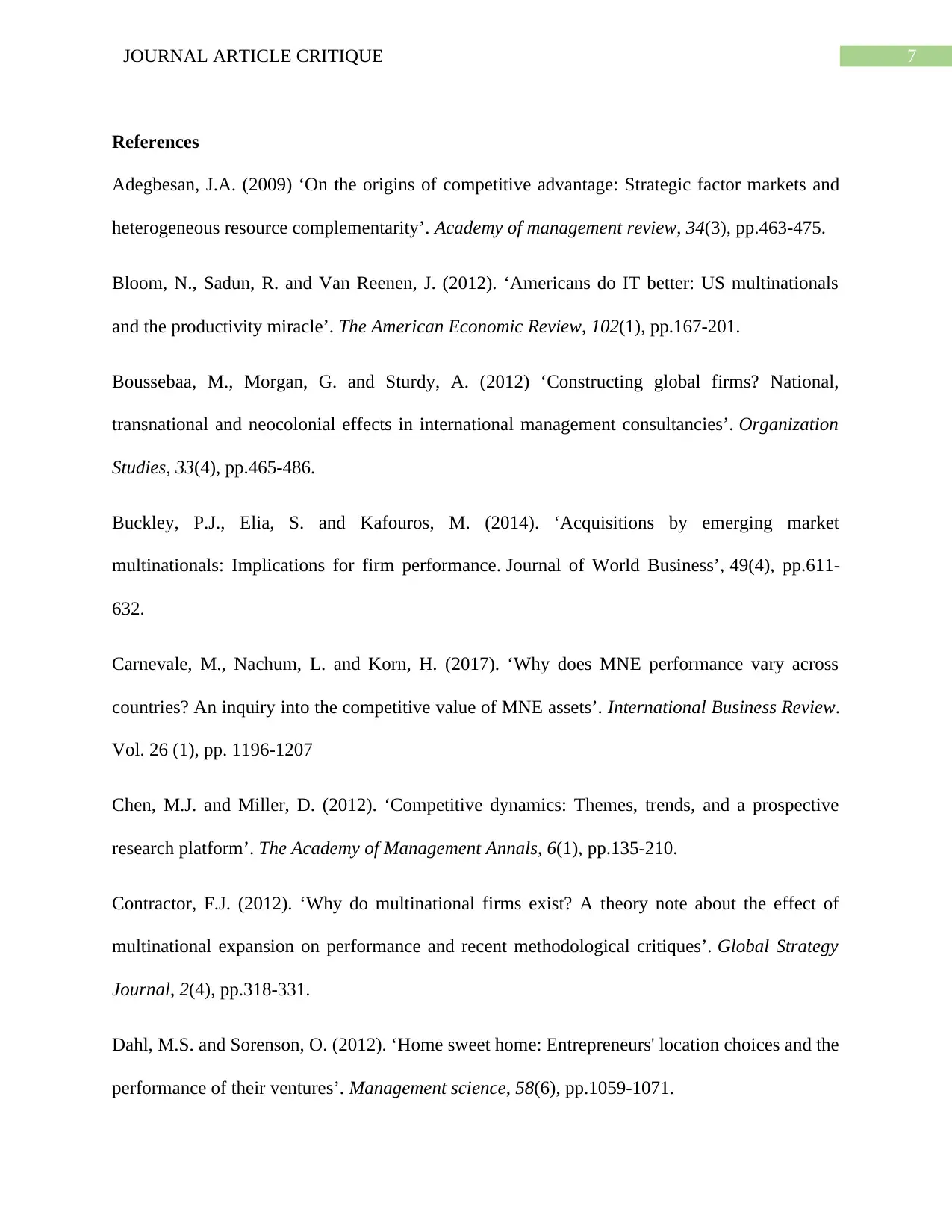
7JOURNAL ARTICLE CRITIQUE
References
Adegbesan, J.A. (2009) ‘On the origins of competitive advantage: Strategic factor markets and
heterogeneous resource complementarity’. Academy of management review, 34(3), pp.463-475.
Bloom, N., Sadun, R. and Van Reenen, J. (2012). ‘Americans do IT better: US multinationals
and the productivity miracle’. The American Economic Review, 102(1), pp.167-201.
Boussebaa, M., Morgan, G. and Sturdy, A. (2012) ‘Constructing global firms? National,
transnational and neocolonial effects in international management consultancies’. Organization
Studies, 33(4), pp.465-486.
Buckley, P.J., Elia, S. and Kafouros, M. (2014). ‘Acquisitions by emerging market
multinationals: Implications for firm performance. Journal of World Business’, 49(4), pp.611-
632.
Carnevale, M., Nachum, L. and Korn, H. (2017). ‘Why does MNE performance vary across
countries? An inquiry into the competitive value of MNE assets’. International Business Review.
Vol. 26 (1), pp. 1196-1207
Chen, M.J. and Miller, D. (2012). ‘Competitive dynamics: Themes, trends, and a prospective
research platform’. The Academy of Management Annals, 6(1), pp.135-210.
Contractor, F.J. (2012). ‘Why do multinational firms exist? A theory note about the effect of
multinational expansion on performance and recent methodological critiques’. Global Strategy
Journal, 2(4), pp.318-331.
Dahl, M.S. and Sorenson, O. (2012). ‘Home sweet home: Entrepreneurs' location choices and the
performance of their ventures’. Management science, 58(6), pp.1059-1071.
References
Adegbesan, J.A. (2009) ‘On the origins of competitive advantage: Strategic factor markets and
heterogeneous resource complementarity’. Academy of management review, 34(3), pp.463-475.
Bloom, N., Sadun, R. and Van Reenen, J. (2012). ‘Americans do IT better: US multinationals
and the productivity miracle’. The American Economic Review, 102(1), pp.167-201.
Boussebaa, M., Morgan, G. and Sturdy, A. (2012) ‘Constructing global firms? National,
transnational and neocolonial effects in international management consultancies’. Organization
Studies, 33(4), pp.465-486.
Buckley, P.J., Elia, S. and Kafouros, M. (2014). ‘Acquisitions by emerging market
multinationals: Implications for firm performance. Journal of World Business’, 49(4), pp.611-
632.
Carnevale, M., Nachum, L. and Korn, H. (2017). ‘Why does MNE performance vary across
countries? An inquiry into the competitive value of MNE assets’. International Business Review.
Vol. 26 (1), pp. 1196-1207
Chen, M.J. and Miller, D. (2012). ‘Competitive dynamics: Themes, trends, and a prospective
research platform’. The Academy of Management Annals, 6(1), pp.135-210.
Contractor, F.J. (2012). ‘Why do multinational firms exist? A theory note about the effect of
multinational expansion on performance and recent methodological critiques’. Global Strategy
Journal, 2(4), pp.318-331.
Dahl, M.S. and Sorenson, O. (2012). ‘Home sweet home: Entrepreneurs' location choices and the
performance of their ventures’. Management science, 58(6), pp.1059-1071.
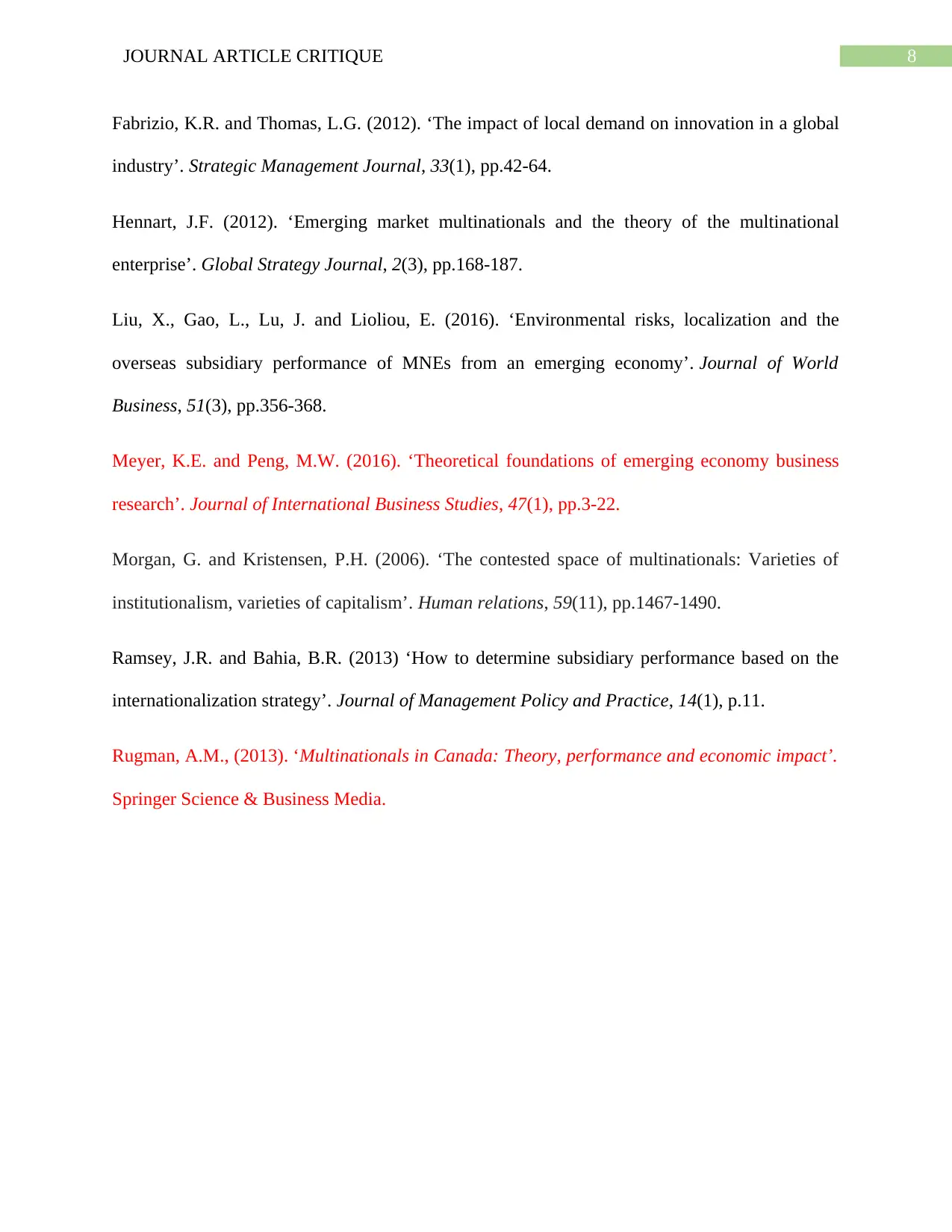
8JOURNAL ARTICLE CRITIQUE
Fabrizio, K.R. and Thomas, L.G. (2012). ‘The impact of local demand on innovation in a global
industry’. Strategic Management Journal, 33(1), pp.42-64.
Hennart, J.F. (2012). ‘Emerging market multinationals and the theory of the multinational
enterprise’. Global Strategy Journal, 2(3), pp.168-187.
Liu, X., Gao, L., Lu, J. and Lioliou, E. (2016). ‘Environmental risks, localization and the
overseas subsidiary performance of MNEs from an emerging economy’. Journal of World
Business, 51(3), pp.356-368.
Meyer, K.E. and Peng, M.W. (2016). ‘Theoretical foundations of emerging economy business
research’. Journal of International Business Studies, 47(1), pp.3-22.
Morgan, G. and Kristensen, P.H. (2006). ‘The contested space of multinationals: Varieties of
institutionalism, varieties of capitalism’. Human relations, 59(11), pp.1467-1490.
Ramsey, J.R. and Bahia, B.R. (2013) ‘How to determine subsidiary performance based on the
internationalization strategy’. Journal of Management Policy and Practice, 14(1), p.11.
Rugman, A.M., (2013). ‘Multinationals in Canada: Theory, performance and economic impact’.
Springer Science & Business Media.
Fabrizio, K.R. and Thomas, L.G. (2012). ‘The impact of local demand on innovation in a global
industry’. Strategic Management Journal, 33(1), pp.42-64.
Hennart, J.F. (2012). ‘Emerging market multinationals and the theory of the multinational
enterprise’. Global Strategy Journal, 2(3), pp.168-187.
Liu, X., Gao, L., Lu, J. and Lioliou, E. (2016). ‘Environmental risks, localization and the
overseas subsidiary performance of MNEs from an emerging economy’. Journal of World
Business, 51(3), pp.356-368.
Meyer, K.E. and Peng, M.W. (2016). ‘Theoretical foundations of emerging economy business
research’. Journal of International Business Studies, 47(1), pp.3-22.
Morgan, G. and Kristensen, P.H. (2006). ‘The contested space of multinationals: Varieties of
institutionalism, varieties of capitalism’. Human relations, 59(11), pp.1467-1490.
Ramsey, J.R. and Bahia, B.R. (2013) ‘How to determine subsidiary performance based on the
internationalization strategy’. Journal of Management Policy and Practice, 14(1), p.11.
Rugman, A.M., (2013). ‘Multinationals in Canada: Theory, performance and economic impact’.
Springer Science & Business Media.

9JOURNAL ARTICLE CRITIQUE
1 out of 10
Your All-in-One AI-Powered Toolkit for Academic Success.
+13062052269
info@desklib.com
Available 24*7 on WhatsApp / Email
![[object Object]](/_next/static/media/star-bottom.7253800d.svg)
Unlock your academic potential
© 2024 | Zucol Services PVT LTD | All rights reserved.

